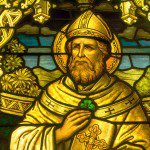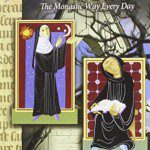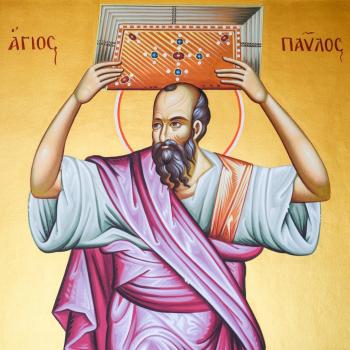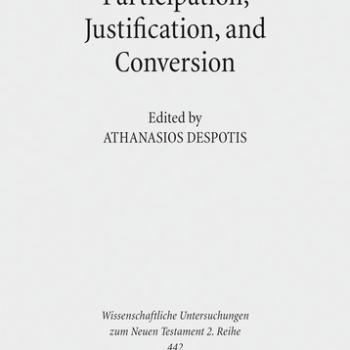Patrick may be the best known of the Celtic saints, but for many people, the heart of the Celtic tradition belongs to Brigid.
Born in the middle of the fifth century, Brigid is according to legend the daughter of a pagan chief and his Christian slave. The story goes that Brigid’s mother worked in the dairy of her master’s household, and that she gave birth at dawn on the morning of February 1, precisely at the moment she was stepping over the threshold into the dairy.
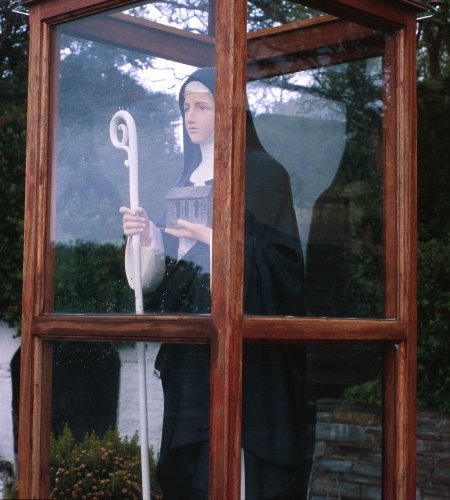
So Brigid is very much a child of the thresholds: she was born neither in the day or the night, neither the winter nor the spring (February 1 corresponds to an ancient pagan holiday that marked the change of the seasons), neither indoors nor outdoors, neither slave nor free, neither pagan nor Christian. But you could turn this around and say that Brigid encompasses all of the above. She is a figure of inclusivity and hospitality.
The beginning of February corresponds to the pagan holiday of Imbolc, one of the four great agricultural festivals of the pre-Christian Celts. Perhaps it is no surprise that the goddess whose cult was most associated with Imbolc was Brigit, the daughter of the great father-god, An Dagda. An Dagda was a “Santa Claus” figure, an archetype of abundance and generosity, a big fat man with a jolly disposition who represented the desire of the ancient Celts for prosperity and abundance. So it’s not surprising that Brigit (the goddess) also had a reputation as a prosperity-deity, and those qualities spilled over onto Brigid (the Saint).
Some historians even question if there ever was a Saint Brigid. Sir James Frazer, author of The Golden Bough, famously wrote “it is obvious that St. Bride, or St. Bridget, is an old heathen goddess of fertility, disguised in a threadbare Christian cloak. Probably she is no other than Brigit, the Celtic goddess of fire and apparently of the crops.” That may be a bit unfair. Perhaps it makes just as much sense to see the historical Brigid as either a woman named for the pagan goddess who embraced Christianity, or perhaps even a priestess of Brigit who embraced the spirituality of Christ. But this is all speculation. In the mists of what we do not know, the line separating Brigit-the-goddess and Brigid-the-saint is barely discernible. And perhaps that’s the way things should be.
Anyway, the folklore surrounding Saint Brigid is rich and evocative. She embraced the spirituality of her mother, and even as a little girl developed a reputation for generosity and hospitality, particularly to the poor. She worked in the kitchen, where apparently she would give food or milk or whatever she could spare to any beggar who happened to stop by. We can assume that word got out among those who relied on the kindness of strangers, and her opportunities for giving would have become more, rather than less, frequent. So the story goes that eventually her father forbade her from giving any more food away. One day her put her in charge of frying some strips of bacon, and the story goes that an emaciated hound appeared at the back door to the kitchen. Overcome with compassion for the stray, Brigid immediately gave the dog three of the five strips of bacon she was cooking (and which her father had counted just a few minutes earlier). Realizing her disobedience, she then prayed over the remaining bacon, and when he father stepped into the kitchen to check on her a few minutes later, he was stunned to find seven slices of bacon in the pan, rather than the original five!
Imbolc was a festival honoring the lactation of the farm animals, and Brigid has a lot of associations with milk — beginning with her mother’s work in the dairy and her own birth on the dairy threshold. As a child, she would be put in charge of churning the butter, and she would divide the butter into thirteen parts, representing Christ and the 12 apostles. The “Christ” portion she would give to the poor, saying “I feed the poor in the name of Christ, for Christ is in the body of every poor person.” She would pray over the churning as she worked, and legend has it that she could fill all the vessels of the region with the butter she churned! Even as an adult, Brigid was associated with an otherworldly cow — milky white but with red ears — that gave an endless supply of milk.
Despite these miracles of abundance associated with her, her father soon grew tired of the girl giving so much away, and so he resolved to marry her off (or sell her off as a slave, depending on which version of the story you hear). He took her to the high king, and left her sitting in his wagon with his own arms (a chieftain would have to disarm before presenting himself before the king). As her father consulted with the king, Brigid, waiting obediently in her father’s wagon, soon saw a beggar walking along the road. She had nothing to give him… but her father’s sword, which she promptly handed over, instructing the poor man to go straight into town and sell it promptly. Eventually her father and the king came out to see the girl, but when he noticed his sword was missing, he asked Brigid what happened, and no sooner had she said “there was this beggar…” when he raised his hand to strike her in anger. The king intervened, saying “This young lady is too holy to live under my roof, I am not worthy of her.” Although what he may have been thinking was something like “I’ll not have her giving away my possessions!”
As she grew up, Brigid discerned a call to enter religious life, but her father had different ideas. He would arrange for potential suitors to come visit the attractive young woman. Finally she took matters into her own hands — literally. One day when a suitor arrived, before presenting herself to her caller, Brigid gouged one of her eyes out of its socket, using only her bare hands. Presenting herself to the youth, he understandably turned away in horror. Once he left, Brigid promptly healed her eye, and the defiance in her gaze made her father understand that she simply would not stand for marriage. So with his reluctant blessing she left home to establish her monastic community in Cill Dara — what is now known as Kildare — or “the Cell of the Oak” (Perhaps the oak is another pre-Christian allusion, suggesting the tree traditionally venerated by druids).
Numerous remarkable folktales surround the establishment of the monastery in Kildare. One of the most remarkable involves how Brigid came to possess the lands for her community. She turned to the local chieftain and asked for land. He was not a particularly generous fellow, so he rather rudely suggested she could have as much land as her mantle could cover. Undeterred, Brigid took of her cloak and threw it on the ground — and the garment magically grew and grew until it covered nearly 5000 acres! Indeed, this land became known as the Curragh, and it remains common land where livestock is raised and racehorses are trained.
Soon it came time for the Bishop to come and consecrate Brigid as the abbess of her community (like other Celtic monasteries, the community in Kildare included both men and women, making Brigid a woman with spiritual authority over men — a remarkable status for the church of the 5th century). The old bishop, Mél, came to Cill Dara with an acolyte, and performed the consecration ritual outdoors (presumably under the oak tree for which Cill Dara is named). Just as he began to pray, a gust of wind blew the pages of his missal, turning from the blessing of an abbess to the consecration of a bishop. Despite the protestations of the acolyte, Bishop Mél recited the words of episcopal consecration over the young nun. When finally the acolyte pointed out his error, the phlegmatic bishop assumed that it must have been the doing of the Holy Spirit.
Even into the present day, Brigid is typically depicted in icons or statuary has holding a bishop’s crozier. Of course, the crozier is also the staff of an abbot (or abbess), so in itself it doesn’t signify much, but it does seem to reinforce the idea that this saint was not only an abbess, but even a kind of proto-female bishop!
This is the first of a two-part series on Saint Brigid. Click here to read part two.
Enjoy reading this blog?
Click here to become a patron.



